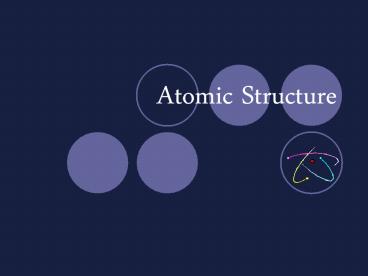Atomic Structure - PowerPoint PPT Presentation
1 / 23
Title:
Atomic Structure
Description:
Title: Chapter 5: Periodic Table Author: IS Department Last modified by: Teacher Created Date: 3/19/2000 8:19:07 PM Document presentation format: On-screen Show (4:3) – PowerPoint PPT presentation
Number of Views:95
Avg rating:3.0/5.0
Title: Atomic Structure
1
Atomic Structure
2
ELEMENTS
- 115 known elements
- 90 naturally occurring elements
- 14 most common elements
- hydrogen (H) carbon (C)
- nitrogen (N) oxygen (O)
- sodium (Na) magnesium (Mg)
- aluminum (Al) silicon (Si)
- phosphorous (P) sulfur (S)
- chlorine (Cl) potassium (K)
- calcium (Ca) iron (Fe)
- CHONPS elements important for life
3
ELEMENTS
- all atoms of a specific element have the same
number of protons - atoms of different elements have a different
number of protons - arranged on Periodic Table to show trends
4
PERIODIC TABLE
5
ATOMIC SIZE
6
SIZE
- 1 mL H2O
- 100,000,000,000,000,000,000,000 atoms
- 1023 atoms
- this is more than the number of drops of water
in all lakes, rivers, and streams on Earth - Special microscopes for studying atoms
- transmission electron microscope
- scanning tunneling microscope
7
INSIDE AN ATOM
8
NUCLEUS
- 1 millionth of the volume of atom
- 99.9 of the mass of an atom
- very, very dense
- contains
- protons
- neutrons
9
PROTON p
- positive (1) charge
- mass 1.673 x 10-24 g 1 amu
- amu atomic mass unit
- all identical
- strong nuclear force holds them together
10
NEUTRON n0
- NO charge
- mass 1 amu
- all identical
- the number of neutrons can vary for a specific
element
11
ELECTRON e-
- negative (-1) charge
- mass 1/1836 of proton 0 amu
- electron clouds
- space in which e- are likely to be found
- e- whirl around nucleus billions of times per
second - impossible to find the exact position of an
electron - more energy means a larger electron cloud
12
ATOM vs. ION
- ATOM
- of protons of electrons
- NO CHARGE
- ION
- A charged atom
- e- lt p indicates a POSITIVE ION
- CATION
- e- gt p indicates a NEGATIVE ION
- ANION
13
SUBATOMIC PARTICLES
Abbreviation Charge Location Mass (AMU) Who? When?
proton p 1 nucleus 1
neutron no 0 nucleus 1
electron e- -1 electron clouds 0
Rutherford 1919
Chadwick 1932
Thomson 1897
14
PERIODIC TABLE SYMBOL
- Element Name
- Atomic Number
- of protons
- Element Symbol
- Atomic Mass (amu)
15
ATOM SYMBOL (chromium-52)
- Mass Number
- protons neutrons
- Atomic Number
- of protons
Element Symbol
16
ATOMIC NUMBER
- Z
- number of PROTONS
- identifies the element
- never, EVER changes for a given element
17
MASS NUMBER
- A
- number of PROTONS NEUTRONS
- mass of atom in amu (almost all mass is in the
nucleus) - neutrons mass number atomic number
18
ISOTOPE
- atoms of the same element that have different
numbers of neutrons (different mass numbers) - similar chemical properties, but different mass
- isotopes are named for their mass number, for
example - chlorine-35 ? 35Cl
- chlorine-37 ? 37Cl
19
ISOTOPE EXAMPLE
- carbon-12
- 6 protons
- 6 neutrons
- carbon-14
- 6 protons
- 8 neutrons
20
ISOTOPE EXAMPLE
21
ION SYMBOL
- Mass Number
- protons neutrons
- Atomic Number
- of protons
Ion Charge
2
this atom must have LOST 2 ELECTRONS to become a
2 ION
22
POSITIVE ION ? CATION
- atom that has lost electrons
- Protons?
- 13
- Neutrons?
- 14
- Electrons?
- 10
Al
3
27 13
23
NEGATIVE ION ? ANION
- atom that has gained extra electrons
- Protons?
- 34
- Neutrons?
- 45
- Electrons?
- 36
Se
-2
79 34































